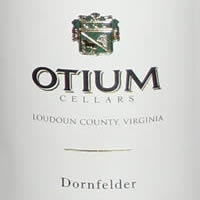Otium Cellars Loudoun County (Virginia) Dornfelder 2009 ($22)
I gave this wine 93 points when I tasted it. I hate to go all Parker on you, but my point is that I rated more than two dozen wines higher than that. And this was just a wine I tasted, not one I enjoyed over the course of an evening.
But here’s the thing: I tasted this wine in early October, and I’ve been thinking and talking about it ever since.
 The only other wine that stayed with me like that was Domaine Romanee-Conti Montrachet 2008, which I gave 99 and might give 100 in retrospect, as I think it’s the greatest Chardonnay I’ve ever had. That wine’s price initially looks similar to the Otium Dornfelder. Spin it out one digit at a time: $ .. 2 … 2 … 2 … 5. Yep, $2225. I loved it, but I’d rather have 100 bottles of the Dornfelder, easier said then done as only 1200 were made.
The only other wine that stayed with me like that was Domaine Romanee-Conti Montrachet 2008, which I gave 99 and might give 100 in retrospect, as I think it’s the greatest Chardonnay I’ve ever had. That wine’s price initially looks similar to the Otium Dornfelder. Spin it out one digit at a time: $ .. 2 … 2 … 2 … 5. Yep, $2225. I loved it, but I’d rather have 100 bottles of the Dornfelder, easier said then done as only 1200 were made.
So rather than pick an unaffordable wine as my Wine of the Year, I picked an unobtainable one. See: I’m hip. (How many hipsters does it take to change a light bulb? Answer: It’s a really obscure number, you probably wouldn’t know it.)
Here’s why. For my Winery of the Year, I made a statement, urging you to support The Winery Closest to You. This wine is a major reason.
I tried it in the tasting room of 8 Chains North, a Virginia winery owned by Ben Renshaw, who planted Otium’s vineyard and makes the wine. But you have to give Otium owner Gerhard Bauer credit for deciding to plant Austrian grapes, including Blaufrankisch, which seem to do well in Virginia’s hot, humid summers and wet autumns.
The Dornfelder is earthy and musky on the nose: I kept sticking my nose back in it like a furry animal had just nipped around the corner, and I was trying to get another glimpse. There’s blackberry and cherry fruit, and also some leatheriness.
The first taste is usually, but not always, cherry fruit, but the earthiness is right there soon enough. There’s some tangy orange peel, a good quality to keep bringing you back. It’s texturally pleasurable, with a medium body and tannins like soft fingers. When I was in the room with it, I kept wanting to put down whatever else I had in my hand to go back to it.
And it’s only 12.5% alcohol. In the first draft of these tasting notes I led with that, but don’t want to make this choice any more of a political statement than it already is. I love its low-alcoholness, but I drank a bunch of other wines in that range this year and this is the only one I obsess on, not that I’ll ever taste it again.
So why’d I pick it? Because it means something to me: It means that one of my favorite wines of the year, a wine I weighed against DRC Montrachet for this choice, can come from somewhere in the US outside the West Coast. It means that drinking New Mexico or Texas or Michigan wines isn’t a mercy purchase: It’s a shot at world-class, No. 1 level greatness.
I was criticized recently by a Virginia wine blogger for condescending to the wine scene there by writing a Wine Review Online column about RdV, which may be the state’s best winery. He said, rightly, I wasn’t giving Virginia enough credit. Point taken, but I’m not alone.
So this fits in with my Winery of the Year selection. Maybe there’s not a wine this fine being made in your state. But wines like this are out there under the radar: small production, no advertising, a rudimentary website, sold mostly from another winery’s tasting room.
Next year I’ll pick something you can buy. In the meantime, think about all the great local wines that you can buy and I can’t.
Follow me at @wblakegray.
42
